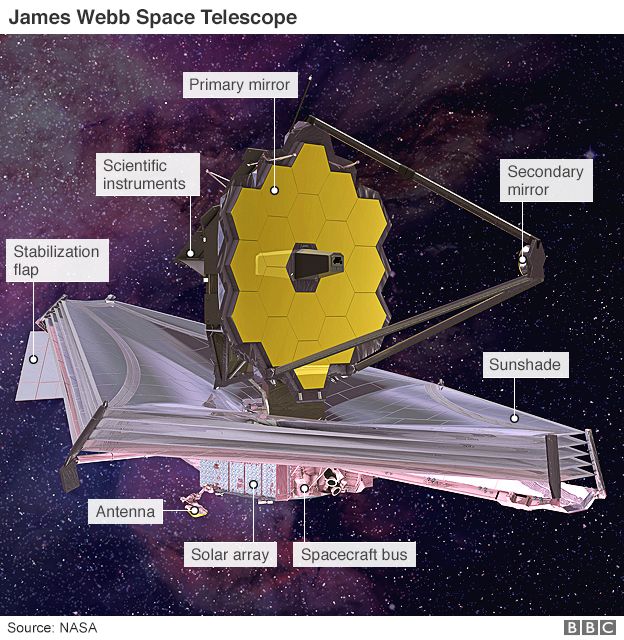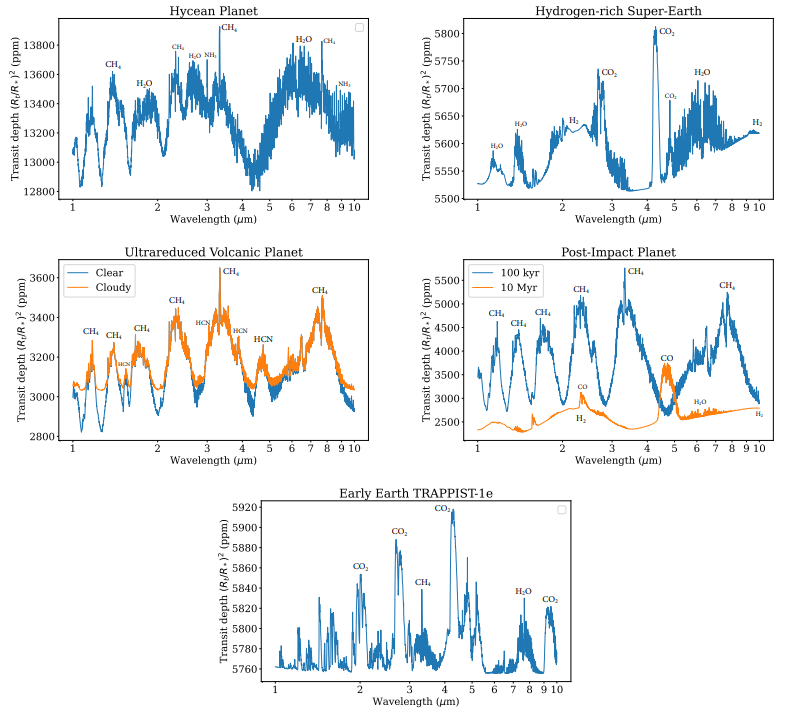And
 National Aeronautics Space Agency/European Space Agency [La Agencia Espacial Europea] [Agence spatiale européenne][Europäische Weltraumorganization](EU)/ Canadian Space Agency [Agence Spatiale Canadienne](CA) James Webb Infrared Space Telescope annotated, finally launched December 25, 2021, ten years late.
National Aeronautics Space Agency/European Space Agency [La Agencia Espacial Europea] [Agence spatiale européenne][Europäische Weltraumorganization](EU)/ Canadian Space Agency [Agence Spatiale Canadienne](CA) James Webb Infrared Space Telescope annotated, finally launched December 25, 2021, ten years late.
The NASA/ESA/CSA James Webb Space based Infrared Astronomy Telescope
8.19.23
Aldo Panfichi
Title: Prebiosignature Molecules Can Be Detected in Temperate Exoplanet Atmospheres with JWST
Authors: A. B. Claringbold, P. B. Rimmer, S. Rugheimer, O. Shorttle
First Author’s Institution: Institute of Astronomy, University of Cambridge, Cambridge, UK
Status: Accepted to AJ
The search for life in the universe has always been a driving force for interest and development of astronomy and the space sciences. Far from tales of little green men and aliens on Mars, today’s scientific investigations into extraterrestrial life usually involve trying to find the traces that life leaves behind in the light that we receive from the stars. This could be evidence of alien transmissions, structures, technology, or intelligence – ‘technosignatures’ – or evidence of molecules or other byproducts of the existence of life, regardless of its intelligence – ‘biosignatures.’
Given many arguments and discussions about the rarity of life in the cosmos, however, many consider it prudent to search not only for these signatures, but also for prebiosignatures – molecules in planetary atmospheres that correspond not to the current existence of life, but to the conditions in which life (organic chemistry, in particular) arose on Earth. These include molecules created by volcanism, UV radiation, or even lightning. Given what we currently understand about how proteins and RNA came to be on our planet, searching for signs of these molecules may help us find the precursors for life elsewhere in the universe.
The authors of today’s paper wish to test the sensitivity of the recently launched Webb telescope to detecting traces of these prebiosignature molecules in the atmospheres of various kinds of exoplanets. To do this, they use atmospheric models to simulate what the transmission spectra of different exoplanets would look like, and test whether Webb’s instruments can recover the prebiosignatures from within the simulated data.
Molecular Mission
The authors chose to focus their analysis on a selection of prebiosignature atmospheric molecules informed by a series of origin scenarios for life. The particular molecules chosen were: hydrogen cyanide (HCN), sulfur dioxide (SO2), hydrogen sulfide (H2S), cyanoacetylene (HC3N), carbon monoxide (CO), methane (CH4), acetylene (C2H2), ammonia (NH3), nitric oxide (NO), and formaldehyde (CH2O).
In order to detect signs of these molecules in the atmospheres of distant planets, scientists use a technique called transmission spectroscopy. Essentially, when a planet crosses in front of its star (or ‘transits’) from our point of view, some light from the planet’s star passes through its atmosphere.

Specific wavelengths of this light are absorbed by molecules in the atmosphere, leaving a telltale ‘fingerprint’ of said molecules’ existence in the spectrum of light we observe. All the molecules chosen happen to have spectral signatures in the infrared, which Webb’s instruments can measure.
Wonderful Worlds
To carry out their investigation, the authors first simulated transmission spectra for a particular set of planets, using models of different types of atmospheres as a background. For the best possible chance of atmospheric detection and characterization, the authors elected to model planets whose atmospheres are rich in hydrogen and helium, have a low mean molecular weight, and are orbiting a smaller star.
Specifically, the authors modeled five different types of possible worlds: a ‘Hycean’ world (an ocean planet, with a hydrogen atmosphere), an ‘ultrareduced volcanic’ world (active vulcanism, with hydrogen- and nitrogen-rich outgassing), a ‘post-impact’ world (a planet recently impacted by another planetary body) at two different times after the collision, a super-Earth planet with a thin hydrogen envelope, and a model which simulates the early conditions on Earth, based on TRAPPIST-1e.

This final model is not a light, hydrogen-rich atmosphere, but is an important one to study, given the history of life’s evolution on our planet. All planets are assumed to be orbiting an M-dwarf star for consistency.

Table 1: Ratios of molecules in each atmospheric model. Table 2 in the paper.

Figure 1: Simulated transmission spectra for each atmospheric model tested, with important spectral lines labeled. Figure 2 in the paper.
Having generated the model transmission spectra, the authors simulated realistic noise that Webb would observe in the data given the M-dwarf star and Webb’s various spectroscopic instruments. Afterwards, they performed a series of Bayesian detection tests to attempt to retrieve individual molecule abundances from their data. The overall goal of this analysis is an order-of-magnitude estimate of how abundant these molecules would have to be in exoplanet atmospheres in order for Webb to detect them, assuming a ‘modest amount’ of observation time (around 5 transits or less) dedicated to each exoplanet.
Rousing Results
The authors find that for the model Hycean world, all prebiosignatures are detectable with Webb’s instruments. The hydrogen-rich super-Earth also has very good detectability, despite having the atmosphere with the smallest scale height (the ‘higher’ the atmosphere extends, the more light passes through its molecules, and thus the stronger the signal received on Earth). The ultrareduced volcanic world, while it has a large scale height like the Hycean world, generally has worse detection thresholds due to strongly absorbing CH4 and HCN in its atmosphere. The post-impact planets have the highest scale height, and thus are the best suited for detection, with low thresholds for the prebiosignature molecules. Finally, prebiosignatures in the early-Earth model were very difficult to detect with a low number of transits – while some molecules became detectable within 5-10 transits, others require somewhere between 40-100, which might be prohibitively long.
Given the models and method of analysis used, the authors note that these results are optimistic at best, and may not correspond to real observational thresholds. Features such as clouds and atmospheric haze can increase the detectability threshold for different spectral features by hundreds or thousands of times, possibly rendering them undetectable.
Furthermore, a realistic retrieval method (where there is uncertainty in the atmospheric composition or planetary properties of the exoplanet being observed) may affect the detected abundances of trace molecules. That being said, the authors’ attempts to simulate such an analysis show that the primary prebiosignatures are still well detected within an order of magnitude of the previous results.
The key conclusion of this paper is that, in the case of light atmospheres and optimal target planets/systems, the detection of prebiosignatures and exploration of the origin of life is well within the capabilities of Webb. As such, a wealth of data on planetary atmospheres is absolutely within the capabilities of the telescope, and detections of said molecules could very well make the news in the years to come.
See the full article here .
Comments are invited and will be appreciated, especially if the reader finds any errors which I can correct. Use “Reply” at the bottom of the post.

five-ways-keep-your-child-safe-school-shootings
Please help promote STEM in your local schools.
The NASA/ESA/CSA James Webb Space based Infrared Astronomy Telescope is a large infrared telescope with a 6.5-meter primary mirror. Webb was finally launched December 25, 2021, ten years late. Webb will be the premier observatory of the next decade, serving thousands of astronomers worldwide. It will study every phase in the history of our Universe, ranging from the first luminous glows after the Big Bang, to the formation of solar systems capable of supporting life on planets like Earth, to the evolution of our own Solar System.
Webb is the world’s largest, most powerful, and most complex space science telescope ever built. Webb will solve mysteries in our solar system, look beyond to distant worlds around other stars, and probe the mysterious structures and origins of our universe and our place in it.
Webb was formerly known as the “Next Generation Space Telescope” (NGST); it was renamed in Sept. 2002 after a former NASA administrator, James Webb.
Webb is an international collaboration between National Aeronautics and Space Administration, the European Space Agency (ESA), and the Canadian Space Agency (CSA). The NASA Goddard Space Flight Center managed the development effort. The main industrial partner is Northrop Grumman; the Space Telescope Science Institute operates Webb.
Several innovative technologies have been developed for Webb. These include a folding, segmented primary mirror, adjusted to shape after launch; ultra-lightweight beryllium optics; detectors able to record extremely weak signals, microshutters that enable programmable object selection for the spectrograph; and a cryocooler for cooling the mid-IR detectors to 7K.
There are four science instruments on Webb: The Near InfraRed Camera (NIRCam), The Near InfraRed Spectrograph (NIRspec), The Mid-InfraRed Instrument (MIRI), and The Fine Guidance Sensor/ Near InfraRed Imager and Slitless Spectrograph (FGS-NIRISS).
Webb’s instruments are designed to work primarily in the infrared range of the electromagnetic spectrum, with some capability in the visible range. It will be sensitive to light from 0.6 to 28 micrometers in wavelength.


 The European Space Agency [La Agencia Espacial Europea] [Agence spatiale européenne][Europäische Weltraumorganization](EU) Webb MIRI schematic.
The European Space Agency [La Agencia Espacial Europea] [Agence spatiale européenne][Europäische Weltraumorganization](EU) Webb MIRI schematic.

Webb has four main science themes: The End of the Dark Ages: First Light and Reionization, The Assembly of Galaxies, The Birth of Stars and Protoplanetary Systems, and Planetary Systems and the Origins of Life.
Launch was December 25, 2021, ten years late, on an Ariane 5 rocket. The launch was from Arianespace’s ELA-3 launch complex at European Spaceport located near Kourou, French Guiana. Webb is located at the second Lagrange point, about a million miles from the Earth.

What do we do?
Astrobites is a daily astrophysical literature journal written by graduate students in astronomy. Our goal is to present one interesting paper per day in a brief format that is accessible to undergraduate students in the physical sciences who are interested in active research.
Why read Astrobites?
Reading a technical paper from an unfamiliar subfield is intimidating. It may not be obvious how the techniques used by the researchers really work or what role the new research plays in answering the bigger questions motivating that field, not to mention the obscure jargon! For most people, it takes years for scientific papers to become meaningful.
Our goal is to solve this problem, one paper at a time. In 5 minutes a day reading Astrobites, you should not only learn about one interesting piece of current work, but also get a peek at the broader picture of research in a new area of astronomy.






